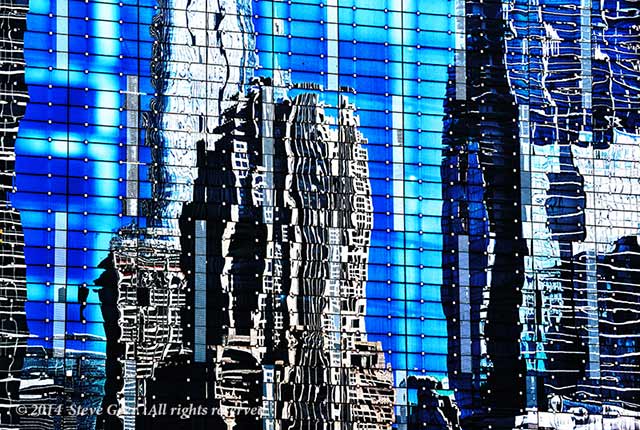
Cityscape reflected in a twenty-first century skyscraper – North Park Drive, Chicago.
Nikon D800, Nikor AF-S 70-200mm f/2.8G ED VR II lens at 135mm,
ISO 100, 1/80 sec, f/8.
Visiting cities or taking a photo walk in your own city presents photo opportunities like no other. There is so much to see and photograph, but the challenge is to find something different and present those scenes in a unique way.
Ideas that help the photographer look for new subjects and new compositions are always welcome. This article explores one such idea, the use of reflections in cityscapes.
In cities all over the world, reflections can be found everywhere, but unless we look for them they can go unnoticed. A good place to begin looking is in those new skyscraper windows, high above street-level. Look with a telephoto lens and there are many frame-filling possibilities. The resulting compositions can vary from distorted cityscapes to completely abstract images of architectural detail full of the amazing elements of color, lines, patterns, shapes and forms.
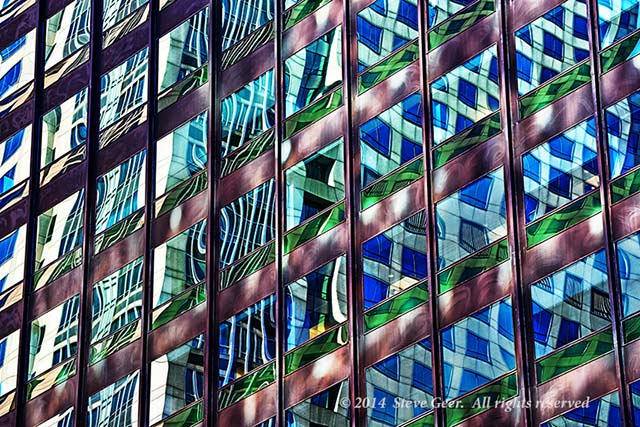
Skyscraper illuminated with indirect light – Gateway Center in Chicago.
Nikon D800, Nikor AF-S 70-200mm f/2.8G ED VR II lens at 140mm,
ISO 100, 1/10 sec, f/14.
The majority of the images presented are from my home base in Chicago, Illinois. In Chicago, old buildings are being torn down and new skyscrapers erected at a phenomenal rate. Almost half of the forty tallest skyscrapers have been built in the last fifteen years. The new buildings are designed to be energy efficient, and therefore have shiny windows that reflect the summer heat. The twenty-first century is transforming Chicago into a city of reflections.
Most of the photographs were made with a single camera-lens combination (Nikon D800 camera and Nikor AF-S 70-200mm f/2.8G ED VR II lens) and my image editing techniques for photo enhancement.
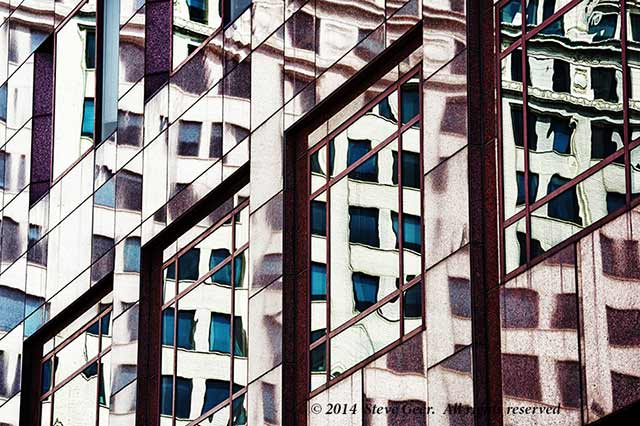
Reflections in marble and glass – One Financial Place in Chicago.
Nikon D800, Nikor AF-S 70-200mm f/2.8G ED VR II lens at 145mm,
ISO 100, 1/20 sec, f/16.
A reflection always distorts the subject. It flips left with right and can distort the reflected subjects in fascinating and interesting ways. In extreme cases, the subject can become completely unrecognizable. The photographic possibilities are further enriched when the reflecting surface is itself interesting. A reflection is, after all, a juxtaposition of the reflection itself and the reflecting surface.
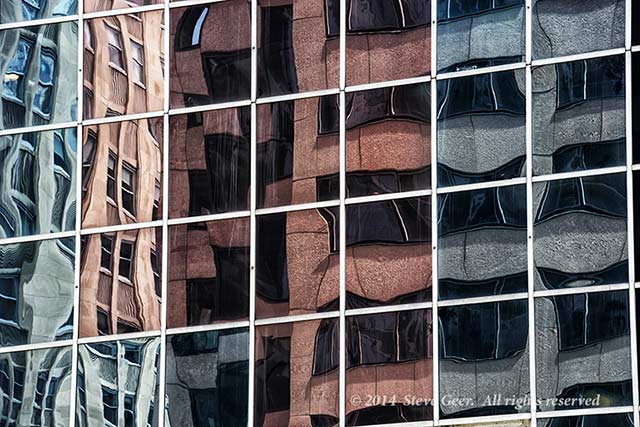
The old reflected in the new – South Wacker Drive in Chicago.
Nikon D800, Nikor AF-S 70-200mm f/2.8G ED VR II lens at 200mm,
ISO 100, 1/5 sec, f/16.
That juxtaposition can be used to explore the relationship between the reflecting and reflected objects, show their similarities, or emphasize their differences, and hence it can be used to tell a story. If the world behind the glass is also visible, the juxtaposition can be even more interesting.
For this type of photograph it is important that both the reflecting surface and the reflection are in focus, which may require choosing a small aperture and using a tripod to enable a long exposure in the reduced light levels typical of city streets.
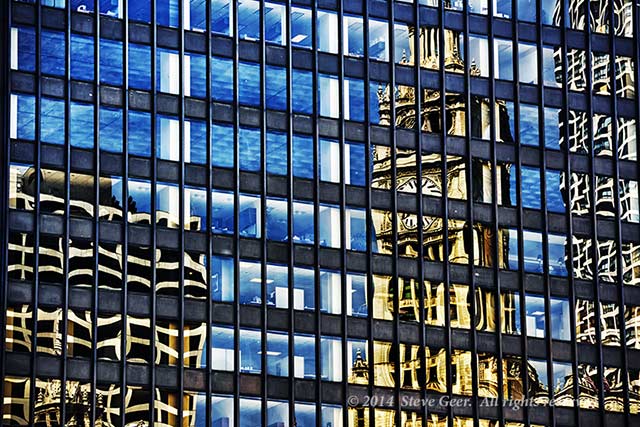
Two worlds behind and in front of the glass –
Wrigley and Equitable Buildings, Chicago.
Nikon D800, Nikor AF-S 70-200mm f/2.8G ED VR II lens at 155mm,
ISO 100, 1/100 sec, f/5.
Contemporary skyscraper architects not only like shiny windows, they also like vast areas of glass. The resulting window arrays can reflect expansive views, creating a cityscape in which some features of the scene are either simplified or exaggerated. The result is a sort of caricature of the city, offering an interesting alternative to the straight cityscape. If you are lucky, that cityscape might contain a recognizable landmark, like the Willis Tower in Chicago, or the Eiffel Tower in Paris. Familiarity with the undistorted object adds extra interest for the viewer, particularly if there are discontinuities between the panes of glass doing the reflecting. The scene will then be broken up, and the urge to mentally straighten it out is almost irresistible.
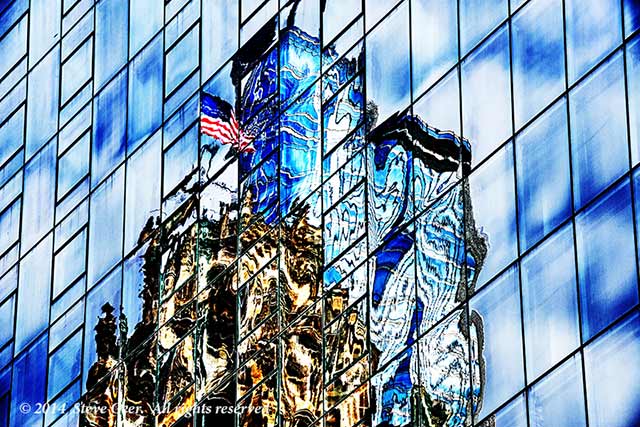
Reflections of city landmarks – Tribune and Trump Towers in Chicago.
Nikon D800, Nikor AF-S 70-200mm f/2.8G ED VR II lens at 200mm,
ISO 200, 1/100 sec, f/14.
A reflected cityscape works best when the buildings being reflected are sunlit, which usually means that the reflecting surface is facing away from the sun. For the best reflections, look for windows in shadow.
Not all of the interesting reflections are high up, which is good news for those of us that get stiff necks. Any shiny surface at street level or a little bit above or below is worth inspecting. I find myself looking for reflections that capture the character of the city in some form; its colors or its ordered chaos, for example.
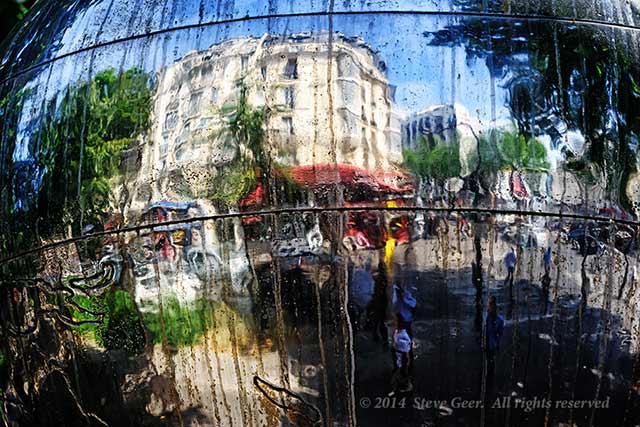
Paris street scene reflected in a shiny metal globe.
Nikon D800, Nikor AF-S 70-200mm f/2.8G ED VR II lens at 165mm,
ISO 100, 1/100 sec, f/9.
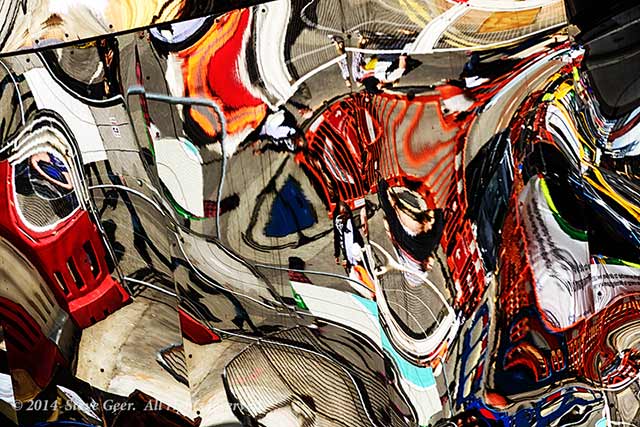
City street scene in Birmingham, England – Reflections in New Street Station.
Nikon D800, Nikor AF-S 70-200mm f/2.8G ED VR II lens at 200mm,
ISO 100, 1/80 sec, f/11.
Wet pavements, particularly if there are puddles, are also fertile ground for producing interesting reflections. Since the surface is horizontal, if the reflection is of something in front of us the subject will be flipped vertically. This can be exploited to capture the viewer’s attention by re-flipping the reflection vertically in the digital darkroom and, with some images, creating an apparent gravity-defying paradox. The result can be quite surreal. Wet pavements also introduce an interesting texture that can complement the reflection. If the pavement is dark it will darken the sky and can produce a nighttime effect.
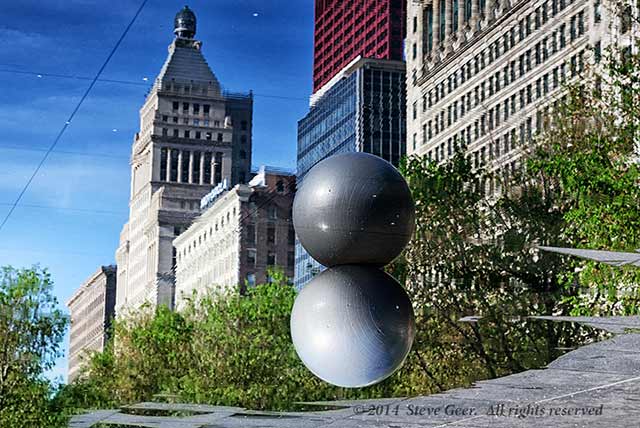
A gravity defying paradox – Beach ball on a wet pavement in Chicago.
Nikon D800, Nikor AF-S 70-200mm f/2.8G ED VR II lens at 90mm,
ISO 100, 1/100 sec, f/8.
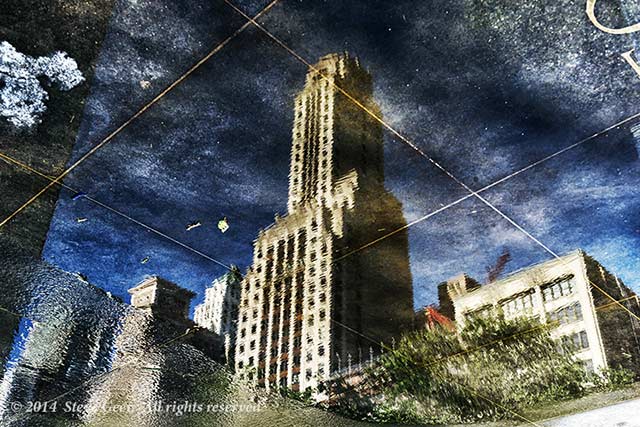
Using pavement texture – South Michigan Avenue in Chicago.
Nikon D800, Nikor AF-S 24-70mm f/2.8G ED lens at 42mm,
ISO 100, 1/50 sec, f/8.
Added benefits: By exploring your own city or a new one, you’ll find new subjects that you would never have seen before. And, it is a great source of exercise. Before you know it, you will have walked miles looking for reflections, all while carrying your camera gear.
Here’s hoping the images have wet your photographic appetite. City reflections provide an endless scope for a wide range of photographs, so take a trip to a city and do some exploration of your own.
by Steve Geer
Text and photos: © 2014 Steve Geer. All rights reserved.

Leave a Reply